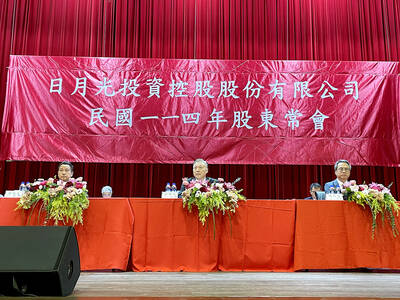DRAM prices are to extend a lengthy upward spiral as robust demand for PCs and data centers is expected to propel prices by 3 to 5 percent this quarter, boding well for the global memory industry’s growth this year, market researcher TrendForce Corp (集邦科技) said.
The potential price hikes in the traditionally slack season would pave the way for annual revenue growth of 30 percent in the DRAM industry to US$96 billion this year, the Taipei-based technology market researcher said.
That follows a 76 percent price jump last year due to a supply crunch.
The final quarter of last year was the best period for the global DRAM industry, with revenue hitting a record high of US$21.9 billion, propelled by a 14.2 percent quarterly increase in prices, according to TrendForce’s tally.
“As for the first quarter of 2018, the latest survey shows that the PC DRAM prices are set at US$33 on average, based on the negotiations between DRAM suppliers and the world’s top three PC vendors,” TrendForce research director Avril Wu (吳雅婷) said in a report released last week. “That represents about a 5 percent increase from the previous quarter.”
Wu’s projection is in line with the estimate of “slight price hikes” by Nanya Technology Corp (南亞科技), the world’s No. 4 DRAM supplier, for the first quarter of this year.
Nanya Technology said robust demand for gaming PCs and corporate notebook computers would support prices.
The prices of DRAM used in servers are to rise between 3 and 5 percent this quarter from a quarter earlier, given persistently vigorous demand from the four major Internet service providers in North America, TrendForce said.
Those companies continued purchasing DRAM for their new data centers, it said.
Mobile DRAM prices are increase at a quarterly pace of 3 percent this quarter in tandem with weaker-than-expected demand for mobile phones in China, after the prices surged 5 to 20 percent in the final quarter of last year, TrendFroce said.
The moderate price increases for the mobile DRAM are also attributable to the Chinese National Development and Reform Commission’s intervention to curb price hikes, the research house said.
On the supply side, Samsung Electronics Co, the world’s biggest memory chipmaker, is set to start a new round of DRAM capacity expansion this year to brace for growing competition from Chinese rivals and to boost profits, TrendFroce said.
Samsung is expected to produce more DRAM on cost-saving and advanced 18-nanometer technology, the researcher said.
The South Korean firm commanded 46 percent of the world’s DRAM market last quarter.
SK Hynix Inc, the world’s No. 2 DRAM supplier, stood pat on its original capacity expansion plans of producing it first 18-nanometer DRAM at the end of this year and ramping up production at a new 12-inch plant in Wuxi, China, next year, TrendForce said.
Micron Technology Inc is to complete its technology migration to 17-nanometer technology from 20-nanomter at a plant in central Taiwan next quarter, the researcher said.
Micron Technology’s Taoyuan plant is to convert half of its installed capacity into 17-nanometer technology by the end of this year, it said.
Nanya Technology is expected to see higher profit margin this quarter, compared with 38.9 percent last quarter, thanks to a faster-than-expected technology upgrade to 20-nanometer technology, TrendForce said.

Greek tourism student Katerina quit within a month of starting work at a five-star hotel in Halkidiki, one of the country’s top destinations, because she said conditions were so dire. Beyond the bad pay, the 22-year-old said that her working and living conditions were “miserable and unacceptable.” Millions holiday in Greece every year, but its vital tourism industry is finding it harder and harder to recruit Greeks to look after them. “I was asked to work in any department of the hotel where there was a need, from service to cleaning,” said Katerina, a tourism and marketing student, who would

i Gasoline and diesel prices at fuel stations are this week to rise NT$0.1 per liter, as tensions in the Middle East pushed crude oil prices higher last week, CPC Corp, Taiwan (台灣中油) and Formosa Petrochemical Corp (台塑石化) said yesterday. International crude oil prices last week rose for the third consecutive week due to an escalating conflict between Israel and Iran, as the market is concerned that the situation in the Middle East might affect crude oil supply, CPC and Formosa said in separate statements. Front-month Brent crude oil futures — the international oil benchmark — rose 3.75 percent to settle at US$77.01

Merida Industry Co (美利達) has seen signs of recovery in the US and European markets this year, as customers are gradually depleting their inventories, the bicycle maker told shareholders yesterday. Given robust growth in new orders at its Taiwanese factory, coupled with its subsidiaries’ improving performance, Merida said it remains confident about the bicycle market’s prospects and expects steady growth in its core business this year. CAUTION ON CHINA However, the company must handle the Chinese market with great caution, as sales of road bikes there have declined significantly, affecting its revenue and profitability, Merida said in a statement, adding that it would

UNCERTAINTIES: The world’s biggest chip packager and tester is closely monitoring the US’ tariff policy before making any capacity adjustments, a company official said ASE Technology Holding Inc (日月光投控), the world’s biggest chip packager and tester, yesterday said it is cautiously evaluating new advanced packaging capacity expansion in the US in response to customers’ requests amid uncertainties about the US’ tariff policy. Compared with its semiconductor peers, ASE has been relatively prudent about building new capacity in the US. However, the company is adjusting its global manufacturing footprint expansion after US President Donald Trump announced “reciprocal” tariffs in April, and new import duties targeting semiconductors and other items that are vital to national security. ASE subsidiary Siliconware Precision Industries Co (SPIL, 矽品精密) is participating in Nvidia